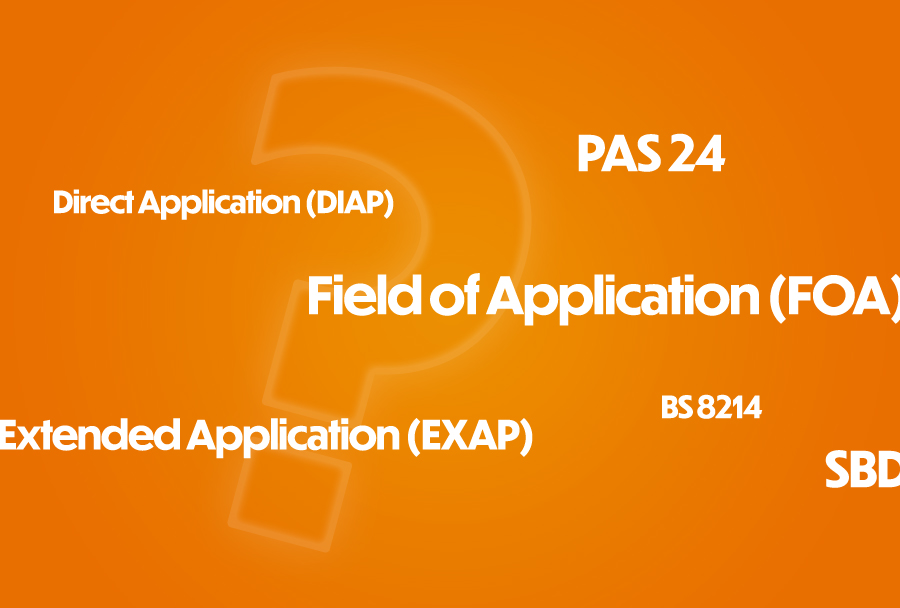Getting to grips with the language of fire door testing
Fire door testing has its own collection of terms and acronyms that can be bewildering to the uninitiated. Here we explain some of terms you are most likely to come across.
1. Field of Application (FOA)
A Field of Application report (sometimes referred to as a Global Assessment) outlines the performance that can be achieved of a specified door design following successfully testing it for fire resistance and extrapolating the results it achieved to define what variables from the tested specification is permitted, whilst maintaining the required level of fire performance. For example, the test results of a fire door of one size and with a certain amount of glazing could still apply to a door of a different size and with a different amount of glazing, but only if the differences are within the parameters specified in the FOA report. Every fire door supplied is accompanied with its own FOA report, and the overall Fields of Application are determined by experienced fire engineers following specific industry wide guidelines.
2. DIAPs (Direct Applications)
When testing to European test standards, e.g. BS EN 1634-1, the fire test report may include a Direct Field of Application (DIAP), which outlines very conservative and limited variations from the design which was fire tested, based on the level of ‘over-performance’ of the test specimen. These are the starting points for the Extended Field of Application reports (EXAPs) and relate to the specific results obtained from testing a particular door design. (Note that this relates to the entire doorset, including essential door fittings, any glazed apertures fitted, intumescent seals and the door frame).
3. EXAPs (Extended Applications)
It would be impractical to test every single variant of fire door in every conceivable setting; the permutations would soon run into thousands and more. This is where FOA’s and EXAP’s come in, as they allow the results obtained from successful fire tests to be evaluated and conservative variants identified.
4. BS 8214
Another key standard in the fire door world is BS 8214, which gives recommendations for the specification, installation and maintenance of fire doors. BS 8214 effectively requires fire doors to provide a similar level of fire resistance as the walls and floors of a building. It also sets out the frequency with which fire doors should be inspected.
5. PAS 24
Fire doors generally not only have to be resistant to fires, but also provide adequate security against intruders. PAS 24 sets a standard of testing for doorsets and windows which means buyers and users can be confident that they are difficult for unauthorised individuals to get through.
6. SBD – Secured by Design
Secured by Design (SBD) was set up by the UK Police Service in 1989 with the aim of reducing crime through improving the physical security of buildings. Products that reach the required standards are accredited by SBD, providing buyers with reassurance that they will provide good security, and companies making these products can become members of the SBD scheme (Solidcor is a member company).
7. Triple Certification
Prior to 1st June 2022, product accreditation for fire doors under the SBD scheme was based on Dual Certification covering their fire prevention and security properties. Since that date, fire doors need to have achieved Triple Certification, which also covers their ability to prevent smoke ingress. This change came about in recognition that smoke lay behind the majority of deaths and injuries related to building fires, and therefore needed to be assessed on an equal footing with fire and security. All doorsets accredited by the SBD (including Solidcor’s) now limit smoke leakage to a maximum of 3m3/h/m (i.e. three cubic metres per hour for each linear metre of door edge).
8. Bi-directional testing
If a fire door is to provide optimal protection, it should be effective at preventing fires spreading regardless of which side of the door the fire is on, especially in blocks of flats and other multi-occupancy buildings. It therefore follows that fire door tests are carried out on a bi-directional basis.
9. Endurance testing
A fire door needs to perform, including as a barrier against fire, not just when installed but for years afterwards. Endurance testing sees doorsets set up in rigs that repeatedly open and close a door to prove its durability. It can then be certified for the relevant number of cycles – this aspect of door performance is measured under BS 6375-2.
10. UKAS
UKAS, which stands for United Kingdom Accreditation Service, is the UK’s national accreditation body. It oversees the organisations that provide testing, calibration and certification services to ensure that they are competent. By doing so, it maintains the integrity of the UK’s testing regime, meaning we can trust that if a product is approved for use, it has been rigorously examined by an organisation subject to UKAS oversight and found to be safe.
We hope this has clarified some of the terminology that crops up around the testing regime for fire doors, but our team would be happy to help explain any other words, abbreviations or terms around fire doors and testing – just call us on 01246 604654.
